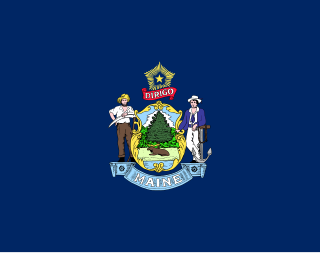
The 10th Maine Infantry Regiment was mustered in for two years of service at Portland, Maine, on October 4, 1861, by then-Major Seth Eastman. It was mustered out on May 8, 1863, also at Portland. The regimental commander was Colonel George Lafayette Beal. The 10th Maine was a re-organization of the 1st Maine Infantry, a regiment primarily composed of men with two-year enlistments that was mustering out after completing three months of Federal service. Eight companies of the 1st Maine were retained in service, with Companies A and D replaced by newly recruited companies.

The 17th Maine Infantry Regiment was an infantry regiment that served in the Union Army during the American Civil War. It was particularly noted for its service during the 1863 Battle of Gettysburg.

The 5th Michigan Infantry Regiment was an infantry regiment from Michigan that served in the Union Army during the American Civil War. The regiment was mustered into federal service in August 1861 and served in the Eastern Theater. It fought in all the major battles of the Army of the Potomac, including Seven Pines, the Seven Days Battles, Second Bull Run, Chantilly, Antietam, Fredericksburg, Chancellorsville, Gettysburg, the Wilderness, Spotsylvania, Cold Harbor, Petersburg, and Appomattox. The regiment was mustered out in June 1865.
The 5th Maine Infantry Regiment was an infantry regiment of the Union Army during the American Civil War.
The 7th Maine Infantry Regiment was an infantry regiment that served in the Union Army during the American Civil War. It participated in most of the campaigns and battles of the Army of the Potomac in the Eastern Theater.

The 63rd New York Infantry Regiment was a Union Army regiment in the Irish Brigade during the American Civil War. It served in some of the leading campaigns and battles of the Army of the Potomac in the Eastern Theater of operations.

The 42nd New York Infantry Regiment, also called the Tammany Regiment, was a regiment of the Union Army during the American Civil War which was formed up in mid-1861 and mustered in on June 22, 1861. It was organized by the Tammany Club, a New York Democratic Party club.

The 125th New York Infantry Regiment was a volunteer regiment from Rensselaer County, New York, during the American Civil War. Formed during the summer of 1862, the unit was officially mustered into United States Service on 27–29 August 1862, by Col. George L. Willard. He had seen previous service in the Mexican War as well. Levin Crandall was commissioned lieutenant colonel, and James C. Bush major. The unit was mustered out on 5 June 1865.

The 106th New York Infantry Regiment was an infantry regiment in the Union Army during the American Civil War.

The 151st New York Infantry Regiment was an infantry regiment in the Union Army during the American Civil War.
Battery H, 1st Ohio Light Artillery was an artillery battery that served in the Union Army during the American Civil War. It was also known as Huntington's Battery.

The 6th Maine Infantry Regiment was an infantry regiment that served in the Union Army during the American Civil War.

The 1st Regiment Massachusetts Volunteer Infantry was an infantry regiment in the Union army during the American Civil War. It was the first regiment to leave Massachusetts for a three-year term in response to President Abraham Lincoln's May 3, 1861, call for three-year regiments. It was also the first three-year regiment from any state to reach Washington, D.C., for federal service. The core of the regiment was five companies from the 1st Massachusetts Volunteer Militia, a peace-time unit which was formed in 1858, replacing an earlier, disbanded unit of the same designation. Five companies of new recruits were added to the regiment and the unit was mustered in by companies beginning May 23, 1861, at Camp Cameron in Cambridge, Massachusetts.

The 13th Regiment Massachusetts Volunteer Infantry was an infantry regiment in the Union Army during the American Civil War. It was formed on July 16, 1861, at Fort Independence in Boston, Massachusetts. Its original commander was Colonel Samuel H. Leonard.

The 126th New York Infantry Regiment was an infantry regiment in the Union Army during the American Civil War.
The 88th Regiment, Pennsylvania Volunteer Infantry was an infantry regiment that served in the Union Army during the American Civil War.

The 2nd Pennsylvania Reserve Regiment also known as the 31st Pennsylvania Volunteer Infantry was an infantry regiment that served in the Union Army as part of the Pennsylvania Reserves infantry division during the American Civil War.
The 11th Pennsylvania Reserve Regiment also known as the 40th Pennsylvania Volunteer Infantry was an infantry regiment that served in the Pennsylvania Reserves infantry division of the Union Army during the American Civil War.

The 61st Regiment, Pennsylvania Volunteer Infantry was an infantry regiment that served in the Union Army during the American Civil War.
The 49th Pennsylvania Volunteer Infantry was an infantry regiment that served in the Union Army during the American Civil War.












